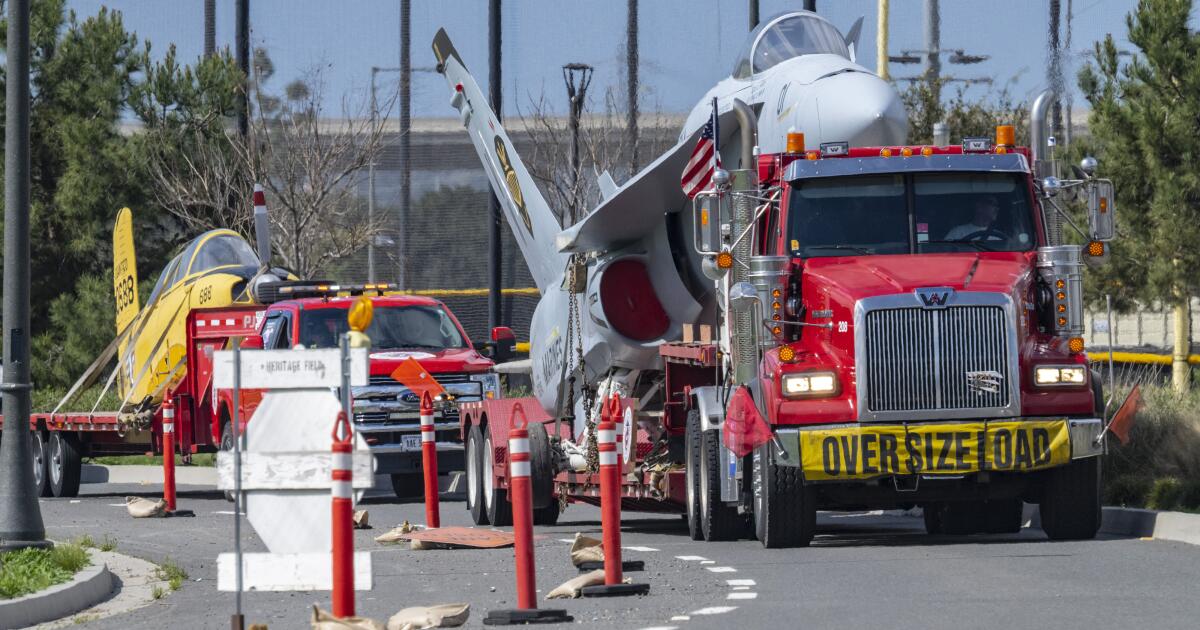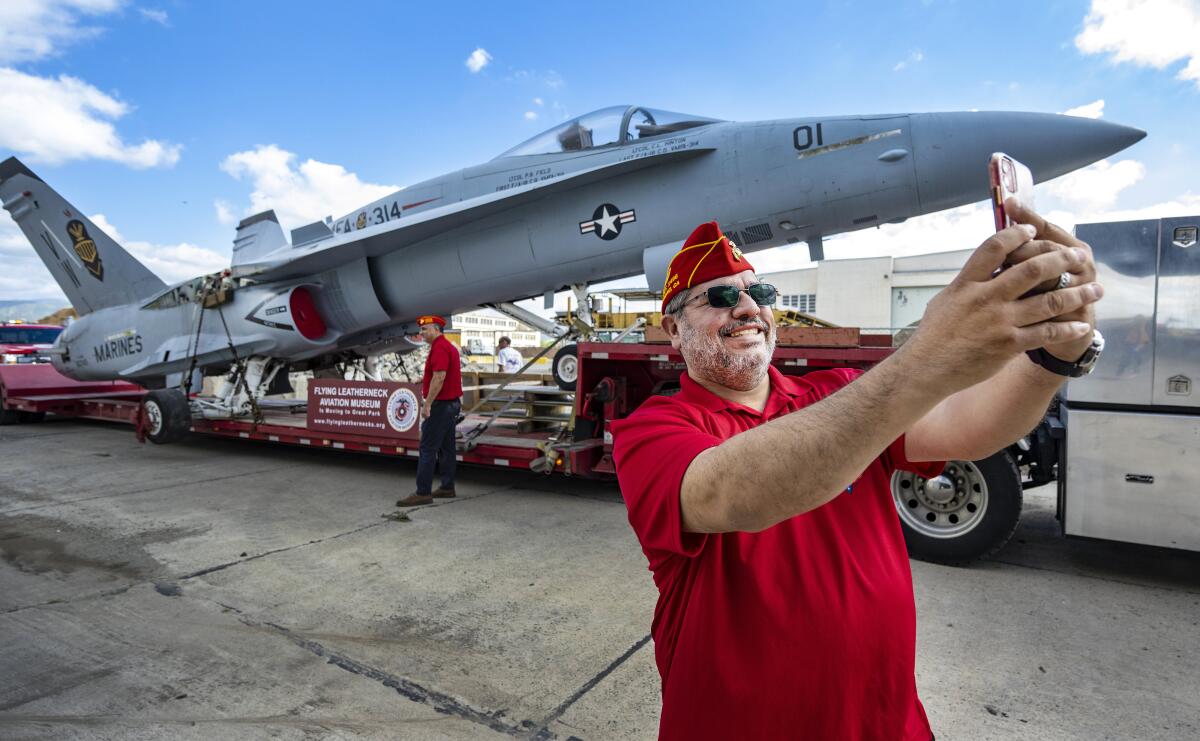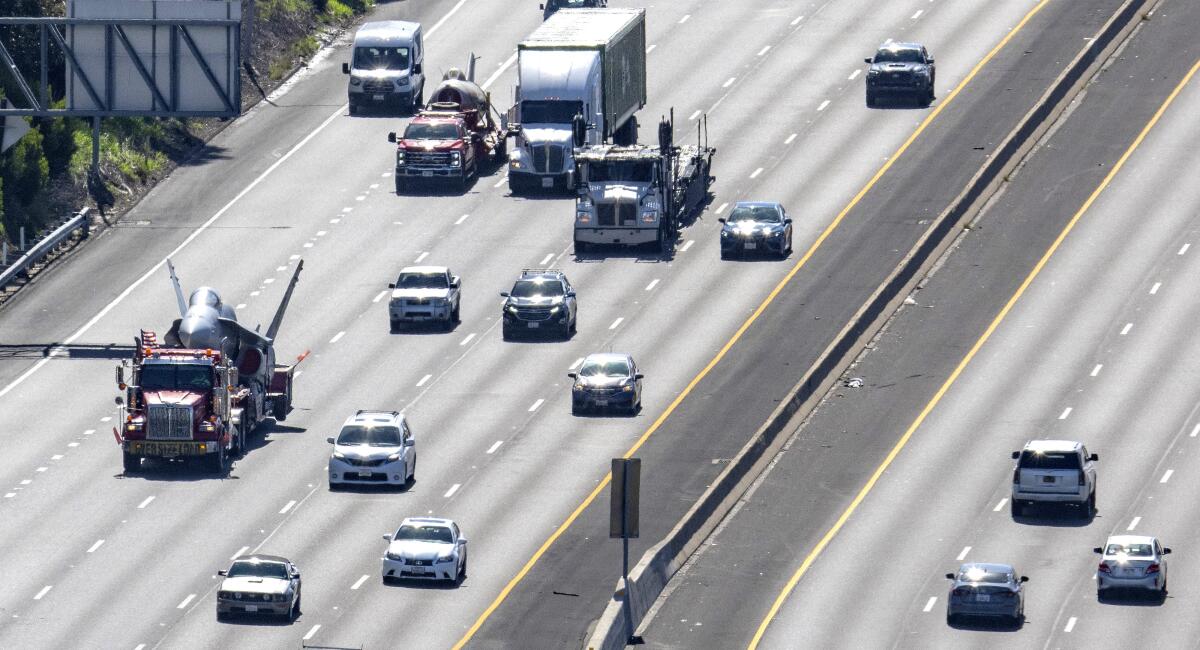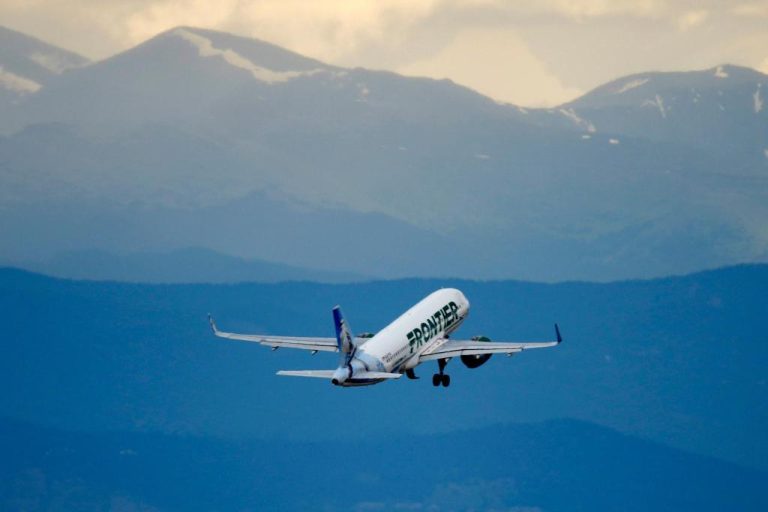
A Beechcraft T-34 Mentor, a Boeing F/A-18 Hornet and a Chinese-made MIG 15 traveling the 5 Freeway caused some excitement and lots of rubbernecking from motorists this week.
The convoy of trailers drove 85 miles on Tuesday from the Marine Corps Air Station Miramar to the planes’ future home at the Irvine’s Great Park.
The three military aircraft are the first of 40 to “land” at Hangar 297, a renovated hangar that was once part of Marine Corps Airstation El Toro and, during its heyday, was the home of an aerial tanker transport squadron.

Gabriel Hurtado of Norwalk with the Marine Corps League, takes a selfie with the Boeing F/A-18 Hornet after it arrived from MCAS Miramar in San Diego at its new home at the Great Park in Irvine on Tuesday, March 5, 2024.
(Mark Rightmire / Orange County Register)
The aircraft are all Marine fixed-wing or rotary, and as they arrive over the next few months will be stored at the hangar, where restoration work will be done for the next two years in preparation for the opening of the new Flying Leatherneck Aviation Museum in early 2026.
“The Marines have landed and have the situation well in hand,” said retired Gen. Mike Aguilar, CEO and president of the museum, using a quote made famous by correspondent Richard Harding Davis. “It’s a milestone for us of nearly two years working with the city of Irvine and the Marine Corps getting these aircraft transported.”
Once the museum is completed, the aircraft and other artifacts and exhibits will become a tribute to Southern California Marine aviation history that marked its 100th milestone in 2022. The museum – planned as a 100,000-square-foot facility that will be built close to the old hangar – is a private-public partnership between the Flying Leatherneck Historical Foundation, the city of Irvine and the Marine Corps.
In 2020, the Marine Corps announced plans to close the museum at MCAS Miramar because of a lack of funding. While most of the costs to operate and maintain the museum were funded by the Flying Leatherneck Historical Foundation, the aircraft and facilities belonged to the Navy and Marine Corps.

Two of the three aircraft riding on flatbed trucks make their way along I-5 through San Clemente after departing MCAS Miramar in San Diego to their new home at the Great Park in Irvine on Tuesday morning, March 5, 2024.
(Mark Rightmire / Orange County Register)
With the impending closure, the foundation’s board of directors considered other locations. The city of Irvine reached out about the possibility of locating the aviation museum at the Great Park, which is slowly replacing part of the former Marine Corps Air Station El Toro.
That base was the original home of the aviation museum when it was active in the late 1980s. When El Toro was shuttered in 1999, the aircraft and artifacts of Marine aviation were moved to a command museum at Miramar.
For two years, the aircrafts – including the CH-46 helicopter that evacuated the American ambassador and flag from the roof of the embassy during the fall of Saigon in 1975 – have been sitting outdoors at Miramar.
Because of that, each plane coming to the Great Pak museum is in various stages of renovation. Among the three that arrived on Tuesday, Aguilar said the F/A-18 Hornet is 80% restored. The T-34, a plane used by Navy pilots as a trainer, and the MIG need 100% restoration.
The other planes still at Miramar, including an Iraqi Bell 214 that was a war prize from the Gulf War captured by the 1st Marine division– also need a huge amount of work – it’s all expected to take about two years.
“All the paint on the aircraft needs to be redone,” Aguilar said. “We need to clean up the cockpits and the landing gears. For two years since the museum was closed, they’ve never been touched.”
By mid-March, restoration should be underway in Hangar 297. The foundation has completed its loan agreement with the Marine Corps for the aircraft and has a pre-development agreement with Irvine to begin using the hangar and a final lease agreement for the museum is expected to be finalized later this month, Aguilar said.
In the meantime, the foundation has been prepping the Irvine hangar to receive the aircraft.
“We’ve been making repairs, including working on the electricity and fire suppression,” Aguilar said. “We’ve also installed security measures and a monitoring system.”
When the three planes arrived at the hangar at the Great Park, they were met by a cheering crowd welcoming them to their new home.
For Aguilar, a retired pilot who flew Cobras in the Marines for decades, the experience of following the three large trucks up the freeway was an “emotional, thrilling experience.”
“It was like a parent seeing their child go back home to its original place at El Toro and now the Great Park,” he said.
In the caravan, Agular said the F-18 led the way, adding that it is “such an impressive aircraft.” The Marines still use the fighter jet, but it is slowly being phased out and replaced by the F-35.
Retired Marine Col. Charlie Quilter, an F-4 Phantom pilot and foundation board member, is also overjoyed that physical progress on the museum is moving forward.
“As a Marine aviator and historian, my heart soars like an eagle at this moment,” he said. “Marine aviation has many chapters of heroism and innovation. This museum, with its unique collection of aircraft, artifacts, curated archive, and experimental exhibits, will tell the story well, I think, but it is also a story of California and Orange County.”
Quilter said that beyond the fascinating and heroic history of Marine aviation, there are many other benefits the museum will bring, including playing a role in aerospace technical education with Orange Coast College.
“They need aircraft to work on,” he said, “and Flying Leathernecks has got ’em.”
Ritchie writes for the Orange County Register.






